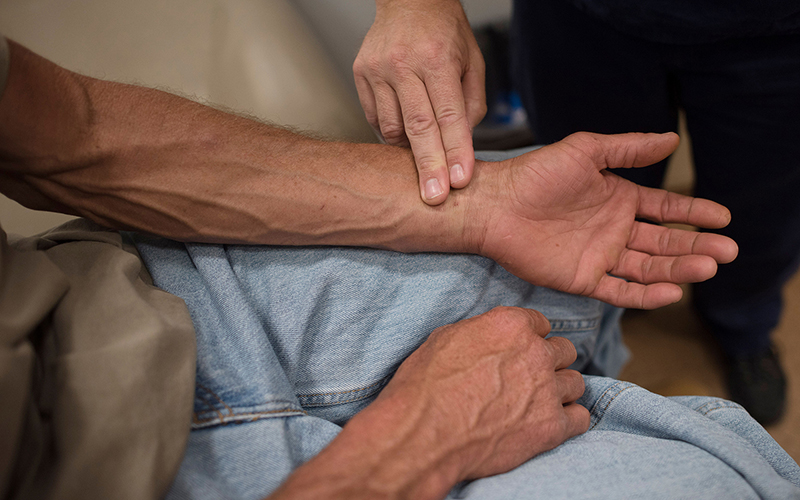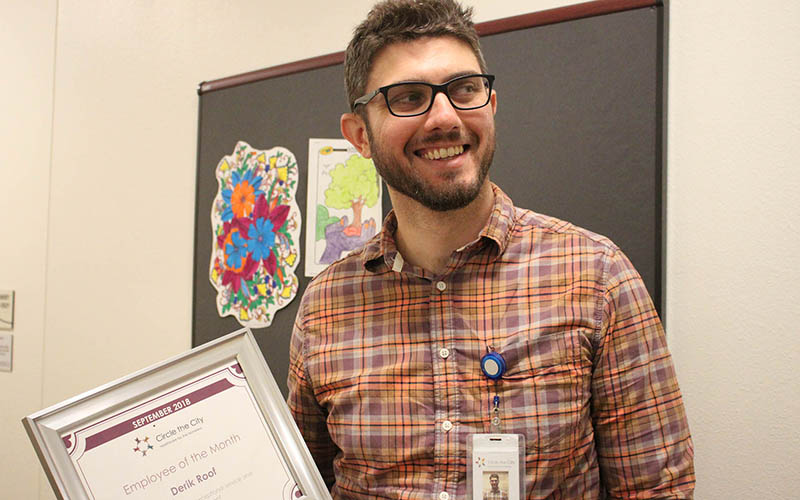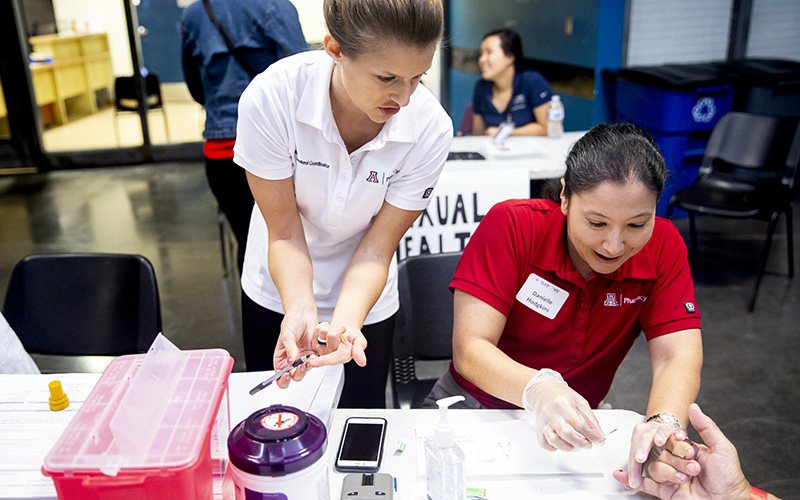
A patient gets his pulse checked at Circle the City, a nonprofit founded in 2008 to deliver health care to homeless people. (Photo courtesy Circle the City)
PHOENIX – David Jarmusz has been through a lot in his 55 years. Diagnosed with HIV in 2009, he suffers from neuropathy, or numbness in his peripheral nerves, and has a hernia in his lower abdomen. He is also a recovering drug addict and a widower who has been homeless off and on for more than 14 years.
Jarmusz had surgery for his hernia in early February. After a single night at the hospital, he said he was put in a cab and dropped off at a homeless shelter in downtown Phoenix. He should have stayed in the hospital longer, but was told that one night was all his state-sponsored health insurance would cover.
Without the proper care and recovery time his surgery demanded, his health only got worse.
Jarmusz’s incision became infected, leaving him with a fever and in severe pain. The infection eventually required another surgery.
It’s not an unusual story. Jarmusz is one of many patients who are discharged from hospitals because they are unable to pay for the treatment and care they need, a practice known as patient dumping. It affects primarily those who are homeless, uninsured or underinsured, or undocumented. They are sent out to recover on their own, without any guarantee they will receive the follow-up care they need or have a safe place to convalesce.
It is dangerous for patients and costly – for them, for health care facilities and taxpayers, who can end up paying for unnecessary follow-up surgeries.
In recent years, a number of hospitals and health care facilities accused of dumping homeless and other patients have been investigated and some have been sued, resulting in hundreds of thousands of dollars in penalties.
Last July, a Los Angeles hospital suspected of leaving hundreds of homeless patients at bus stops and train stations was required to pay $550,000 in legal settlements and agreed to end the practice. Also last year, federal authorities launched an investigation into a Baltimore hospital after a video was posted online, showing an incapacitated woman who had been left at a bus stop in the cold, wearing nothing but a hospital gown.
The Emergency Medical Treatment and Labor Act of 1986 bars hospitals from refusing health care for those in need and makes it illegal to dump patients on the streets, but the practice persists.
Some organizations are fighting to end it, though. One of them is Circle the City, which operates in Phoenix and throughout Maricopa County.
When Jarmusz showed up at Circle the City, he felt defeated by the system. He didn’t trust doctors and felt like he was always being shoved out of medical facilities. His mood started to change when he was assigned a bed at Circle the City and got the health-care services he needed. But after an altercation with staff members there, he was discharged from Circle the City.
Once back on the streets and in homeless shelters, his health again took a turn for the worse. He developed so many sores on his feet that he was nearly unable to walk. And his incision again refused to heal.
That’s when Circle the City took him back in.
“If Circle the City wasn’t here, I wouldn’t have anywhere to go,” Jarmusz said this spring. “This place might’ve saved my life.”
Circle the City is a nonprofit organization founded in 2008 by the Sisters of St. Joseph of Carondelet to deliver health care to homeless people. It now stands nearly alone in that mission after Maricopa County shut down its Health Care for the Homeless program in 2016.
Corinne Velazquez, division director of clinical services for the Maricopa County Department of Public Health, said that after Circle the City expressed interest in filling in the gap, it was allowed to apply for funds previously available to the county program.
But the funding is not enough to meet the demand for the services the Circle the City provides. Public relations director Liz Meyers said Circle the City has grown exponentially in recent years as the homeless population in Phoenix has continued to grow. The organization has added volunteers, increased its budget and forged partnerships with other organizations throughout the Valley.
In August, Circle the City opened its second respite center downtown on the Human Services Campus, the county’s largest homeless-services provider. It serves 800-1,000 people every day. Half as many people again are turned away, as the main shelter is at capacity virtually every night, according to the campus’s welcome center manager.
Although Circle the City’s respite center is considered a homeless shelter, it doesn’t resemble the other buildings and shelters on the campus, which spreads across about four city blocks or 15 acres in downtown Phoenix, near Jefferson Street and 15th Avenue.
Most of the buildings are dimly lit and run-down, with an acrid scent you can smell all the way from outside the front doors of the main building. The walls lack color and the floors are cold, hard concrete similar to the inside of a warehouse. Outside, the artificial grass is permanently flattened by the number of homeless people who set up camp there during the day when the shelters are closed.
But inside Circle the City, the walls are painted in pastel colors, resembling the walls of a children’s hospital. Holiday decorations hang in office windows and are changed every month by a group of volunteers.
There are approximately 50 beds in Circle the City’s downtown location, all newly donated from Phoenix-based mattress manufacturer Tuft and Needle. Nearly every bed remains occupied by a Circle the City patient.
Patients are discharged after they heal, opening space for others. In a best-case scenario, patients would go into transitional housing, but sometimes they heal faster than the time it takes to find stable housing, and the patient has to check back into the campus’ main homeless shelter.
“It really just boils down to a time and a place to heal,” said Derik Roof, a case manager at Circle the City. “We fill an empty space to give those without a place to go and recover.”

Circle the City case manager Derik Roof with an employee-of-the-month award for his work with patients at the Phoenix facility. (Photo by Miranda Faulkner/Cronkite News)
As case manager, it’s Roof’s job to make sure his patients can transition smoothly into housing or another place to stay after they leave respite care.
“For me, it’s about moving people up a step and finding a place to go once they’re healed,” he said. “I hope we can lead them somewhere better; not only physically but also socially.”
He worked closely with Jarmusz during his stay with Circle the City. After Jarmusz’s second hernia surgery, he was placed in an East Valley shelter in early April under outpatient care of Circle the City’s medical providers.
A week after the move, Roof stopped by to check in on Jarmusz. “How ya doing David?”
“I’m walking!” Jarmusz said, throwing his hands up in the air, a genuine smile on his face.
Jarmusz was freshly shaved, well-rested and in shoes that he said made him feel stable enough to help his neuropathy. He had spent the weekend on bed rest after his surgery and said his Circle the City doctor took time come in on a Sunday to check in on how he was feeling.
“I’ve never really had anybody care enough to check in on me like that before,” he said.
Jarmusz came to this organization with a multitude of health problems. He now seems to be on track to living a stable and healthy life.
“I’ve got about six weeks and then I can look into going back to work,” Jarmusz said excitedly in late spring. “That’s all I’ve wanted.”
Since then, Jarmusz’s health has improved and he’s been working. He and Roof have been working to get Jarmusz into a stable housing situation, and Roof said this week that Jarmusz is on a fast track to be in permanent housing by the end of the summer.
“I’m thankful for what I’ve got and the tools I was provided by Circle the City,” Jarmusz said in spring, before adding with a smile, “Maybe one day I’ll have enough money to buy this place and run it my way.”
